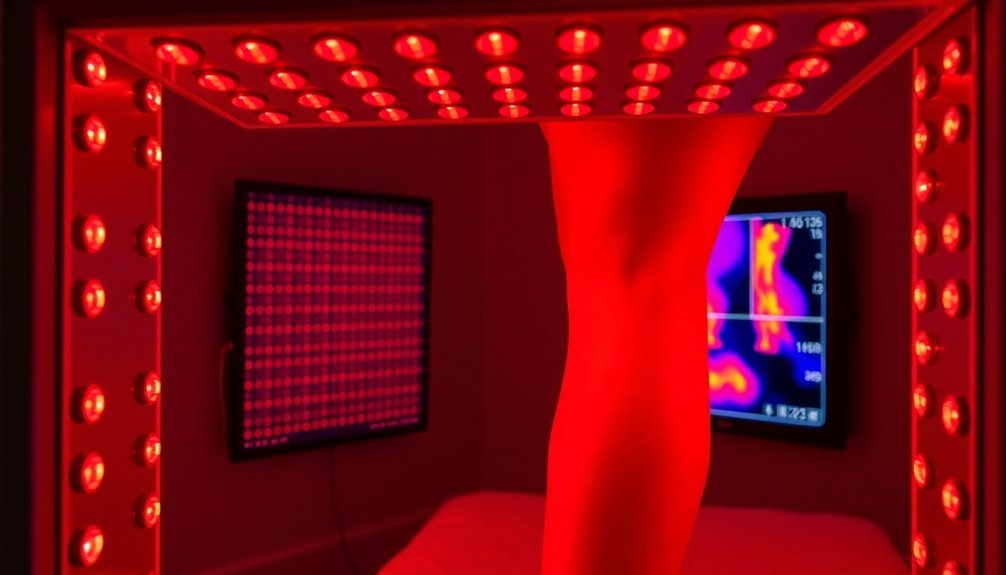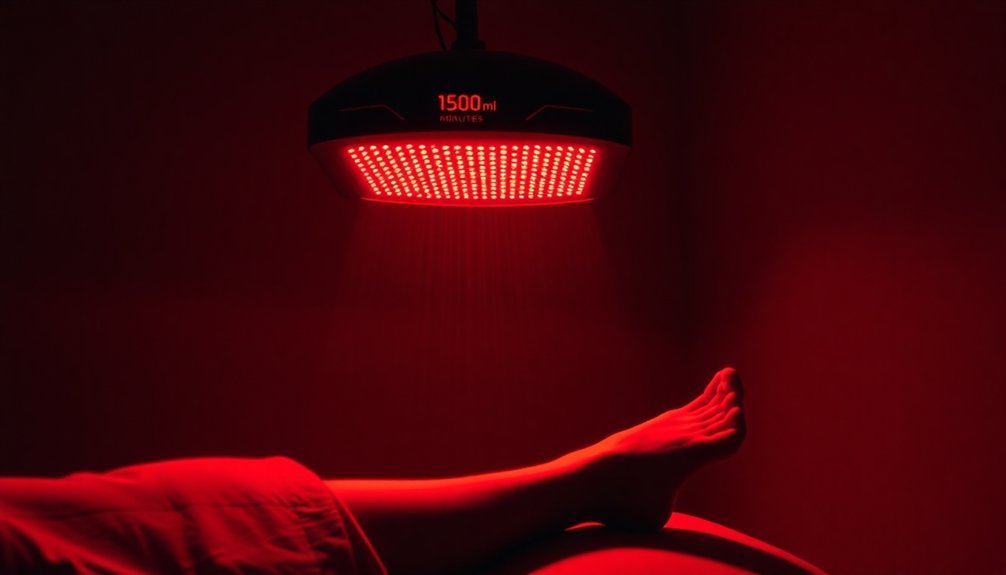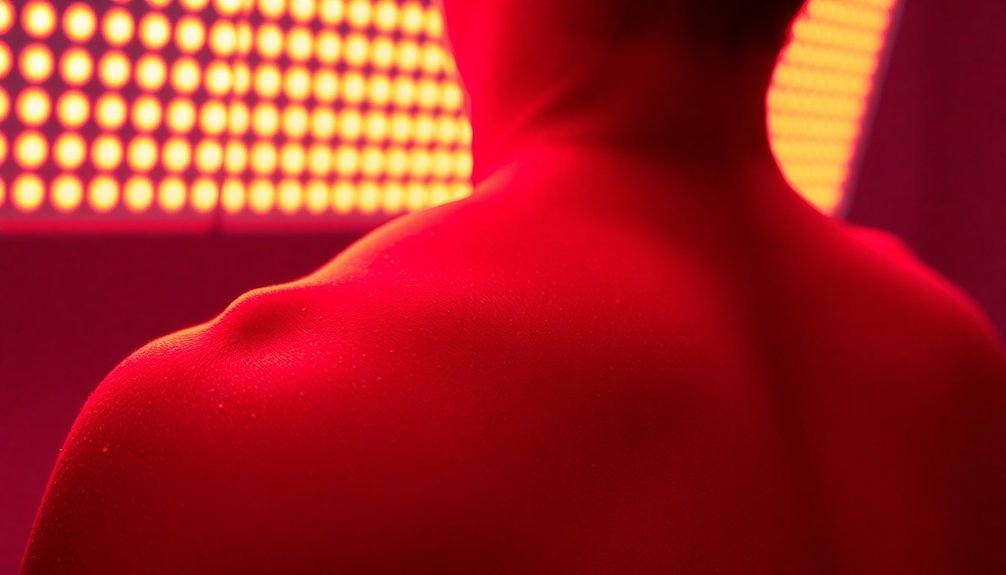Infrared therapy can substantially boost your bone strength through multiple proven mechanisms. It works by stimulating your bone cells' energy production, activating bone-building cells called osteoblasts, and enhancing blood circulation to deliver essential nutrients. You'll experience reduced inflammation within two weeks, improved circulation by week 4, and increased bone density around week 8. The therapy accelerates healing by up to 33% compared to traditional recovery times. For the best results, you'll want consistent exposure to red and near-infrared wavelengths around 850nm. Discover how this revolutionary treatment can transform your bone health through proper application techniques and treatment protocols.
The Science Behind Light Therapy

When near-infrared light penetrates your bone tissue, it triggers several biological processes that enhance bone health. The light waves stimulate your bone cells' mitochondria, increasing ATP production and boosting cellular energy. This process activates osteoblasts, the cells responsible for building new bone tissue.
You'll find that light therapy works through mechanical bio-stimulation, which alters gene expression patterns in your bones. It specifically inhibits sclerostin, a protein that normally blocks bone formation, without causing inflammation. Unlike traditional bur-drilling methods that trigger inflammatory responses, light therapy allows your body to create new bone tissue more effectively while improving blood vessel formation and circulation.
The most effective wavelengths for bone regeneration are in the near-infrared range, around 850 nanometers. At this wavelength, the light can penetrate deeper into your tissue, where it stimulates collagen production and promotes bone neoformation.
While your cells respond to the therapy, they increase their rate of proliferation and enhance the overall bone regeneration process. This cellular response leads to stronger, denser bones and improved skeletal health over time.
Strengthening Bones Through Red Light
The transformative power of red light therapy on bone health extends far beyond basic tissue repair. When you expose your bones to red light, it triggers a cascade of cellular responses that enhance bone strength and accelerate healing.
Your body's natural bone-building mechanisms kick into high gear as the light stimulates mitochondrial function and boosts ATP production. Studies show that exposure to red and near-infrared light leads to increased bone density in treated areas.
Here's how red light therapy strengthens your bones:
- Increases bone density by stimulating osteoblasts (bone-forming cells) and promoting collagen production, making your bones more resilient to fractures
- Accelerates healing of bone injuries by enhancing blood flow and reducing inflammation at fracture sites
- Improves implant stability for dental work by boosting bone formation around the surgical area
- Helps prevent bone loss by reducing osteoclast formation and regulating healthy bone remodeling
You'll find this non-invasive treatment particularly effective when combined with traditional bone therapies. While your body naturally repairs bone tissue, red light therapy amplifies this process by stimulating cellular energy production and promoting better circulation.
The result is stronger, healthier bones with improved mineral density and structural integrity.
Your Recovery Timeline

Understanding your recovery timeline with red light therapy helps you set realistic expectations for bone healing. When you incorporate infrared therapy into your treatment plan, you'll likely experience faster recovery compared to traditional healing methods alone. Studies show that near-infrared light, particularly at 850nm wavelength, penetrates deeply into bone tissue to accelerate regeneration. The therapy's ability to stimulate cellular energy production helps speed up the natural healing mechanisms in damaged bone tissue.
| Timeline | Traditional Healing | With Red Light Therapy |
|---|---|---|
| Week 1-2 | High inflammation | Reduced inflammation |
| Week 3-4 | Limited blood flow | Enhanced circulation |
| Week 5-6 | Gradual cell growth | Accelerated cell proliferation |
| Week 7-8 | Normal bone formation | Increased bone density |
| Week 9-12 | Standard recovery | Complete healing possible |
You'll notice improvements in several key areas during your recovery. Within the first weeks, you'll experience reduced inflammation and improved blood flow. By weeks 3-4, your bone cells will multiply more rapidly than with traditional healing alone. Clinical studies demonstrate that you can achieve complete healing in about 12 weeks with LLLT, compared to standard recovery times of 16-20 weeks. Remember that your specific timeline may vary based on factors like injury severity and treatment consistency.
Proven Health Benefits
When you undergo infrared therapy, you'll experience enhanced bone cell growth through increased osteoblast activity and collagen production, strengthening your skeletal structure naturally.
Your fractures will heal more quickly as the therapy stimulates blood vessel formation and cellular regeneration while promoting callus development around injured areas.
The therapy's powerful anti-inflammatory effects reduce swelling and regulate cytokine levels, creating ideal conditions for your bones to recover and strengthen.
Enhanced Bone Cell Growth
Recent scientific studies have proven that red and near-infrared light therapy substantially enhances bone cell growth through multiple biological mechanisms. When you expose your bones to this therapeutic light, it triggers increased osteoblast activity, leading to faster bone formation and improved density.
The therapy works at a cellular level, boosting ATP production and enhancing blood circulation to support ideal bone regeneration.
Your bones benefit from photobiomodulation in four significant ways:
- Accelerates collagen synthesis and deposition, strengthening the bone matrix
- Increases bone mineral density through enhanced mineralization processes
- Reduces inflammation while regulating bone remodeling cycles
- Stimulates new blood vessel formation for better nutrient delivery
You'll find this non-invasive treatment particularly effective for fracture healing and managing conditions like osteoporosis. The therapy's ability to boost osteogenesis while reducing oxidative stress creates an ideal environment for bone cell growth.
Your body's natural bone-building processes become more efficient as the light therapy stimulates cellular activity and promotes bone neoformation. This makes infrared therapy a powerful tool for maintaining and improving your bone strength.
Faster Fracture Recovery
Building on these bone growth benefits, infrared therapy shows remarkable results in accelerating fracture recovery times. When you're dealing with a bone fracture, infrared light penetrates deep into your tissue, triggering increased blood flow and formation of new blood vessels.
This enhanced circulation delivers essential oxygen and nutrients directly to your injury site, speeding up the healing process.
You'll benefit from the therapy's ability to stimulate osteoblasts – the cells responsible for building new bone tissue. Near-infrared wavelengths around 850nm reach deeper into your bone tissue, promoting faster mineralization and stronger bone formation. This targeted approach helps your fracture heal more efficiently while maintaining ideal bone density.
Clinical studies back these benefits with solid evidence. You're likely to experience reduced pain and improved functionality when you incorporate infrared therapy into your recovery plan. It's particularly effective because it's non-invasive and works alongside traditional treatments without side effects.
Whether you're recovering from a simple fracture or dealing with complex bone injuries, infrared therapy can substantially reduce your healing time while promoting stronger bone reformation.
Reduced Inflammation Benefits
Infrared therapy's powerful anti-inflammatory effects offer you significant relief through multiple cellular mechanisms. When you undergo treatment, infrared light stimulates your body to produce nitric oxide, which relaxes your arteries and improves blood flow.
This enhanced circulation, combined with increased ATP production in your cells, creates an ideal environment for reducing inflammation and promoting healing.
Clinical studies have shown remarkable results in reducing inflammation and managing pain conditions through infrared therapy. You'll experience these benefits through:
- Decreased cytokine production, which directly lowers your body's inflammatory response
- Enhanced mitochondrial function, boosting your cellular energy and repair processes
- Improved collagen production, strengthening your bones and supporting tissue regeneration
- Better joint flexibility and reduced stiffness in your daily activities
You'll find that infrared therapy particularly helps with bone-related inflammation, as it targets the root causes of inflammatory responses at the cellular level. Research shows it can reduce arthritic pain by up to 70% compared to placebo treatments.
When you're dealing with chronic conditions like osteoporosis or persistent joint pain, infrared therapy provides a non-invasive solution that effectively manages inflammation while supporting your overall bone health.
Treatment Tips For Success

When treating bones with red light therapy, you'll want to aim for sessions lasting 10-20 minutes per area, performed 3-5 times per week for the best results.
You'll achieve the finest outcomes using FDA-cleared devices that deliver specific wavelengths between 660-830nm, while avoiding cheaper units that don't provide documented power output or wavelength specifications.
It's crucial to position the device 6-12 inches from your target area and keep the light source completely still during treatment to maintain consistent energy delivery.
Optimal Treatment Duration Tips
For successful infrared therapy targeting bone strength, understanding the ideal treatment duration is essential. While the optimal duration varies based on your specific needs, research shows that consistent shorter sessions often work better than sporadic longer ones.
- Start with 10-minute sessions if you're treating wrist or hand conditions, following a five-times-per-week schedule for two weeks – this approach has shown promising results in clinical studies.
- For dental implant-related treatments, you'll want shorter sessions of about 40 seconds per treatment point, but you'll need to target multiple points around the implant area.
- If you're dealing with acute bone issues, you should aim for daily treatments, as studies on rat bones have demonstrated significant healing improvements with this frequency.
- Consider maintenance sessions to keep your results – while initial treatment might be intensive, you'll likely need ongoing therapy to maintain bone density improvements.
Remember that these durations aren't one-size-fits-all. You'll need to adjust your treatment schedule based on your specific condition, and it's vital to maintain consistency in your chosen treatment duration for the best results.
At-Home Equipment Selection
Now that you understand the timing of treatments, selecting the right at-home equipment will determine your therapy's success.
Focus on devices that offer thorough coverage of the infrared spectrum, particularly those featuring both 660nm and 850nm wavelengths, as these penetrate deep into bone tissue to stimulate healing and regeneration.
Look for FDA-cleared devices from reputable manufacturers who back their products with clinical studies. You'll want equipment that includes adjustable intensity settings and precise computer controls to track your treatment progress.
For bone health specifically, choose devices that have documented success in promoting osteoblast proliferation and increasing bone mineral density.
When evaluating options, consider whether you need full-body coverage or targeted treatment areas. Full-body systems typically deliver better results for overall bone strength, while spot-treatment devices work well for specific problem areas.
Don't forget to verify that your chosen device includes safety features like electromagnetic braking systems and temperature controls. Make sure it's user-friendly with clear instructions and manufacturer support.
If possible, select equipment that offers multiple therapeutic benefits beyond bone health, such as muscle recovery and circulation improvement, to maximize your investment.
At-Home Therapy Guidelines
Safe and effective at-home infrared therapy requires careful attention to guidelines and professional oversight. Before starting treatment, you'll need to consult with your healthcare provider to determine if it's right for you, especially if you're pregnant or have specific health conditions.
When using red light therapy devices, focus on these essential guidelines:
- Use medical-grade devices that meet ISO 13485 standards, featuring wavelengths of ~660 nm (red) and ~850 nm (near-infrared) for the best bone healing effects.
- Follow recommended treatment protocols of 10-minute sessions at an intensity of about 16.21mW/cm2, typically performed 5 times per week.
- Monitor your progress regularly through professional follow-ups, tracking improvements in bone density and pain levels.
- Don't exceed prescribed treatment durations, as the ideal dosages aren't yet fully established by research.
While red light therapy shows promising results for bone healing and density improvement, it's vital to understand its limitations. You shouldn't use it as a standalone treatment for serious conditions like osteoporosis.
Instead, consider it as part of a thorough treatment plan under professional guidance, always prioritizing safety and proper protocol adherence.
Frequently Asked Questions
Can Infrared Therapy Interfere With Medications for Bone Conditions?
Current research shows you shouldn't worry about infrared therapy interfering with bone medications. While it's wise to inform your doctor, there's no evidence of harmful interactions with treatments like bisphosphonates or Prolia.
Is Infrared Treatment Safe During Pregnancy When Experiencing Bone Problems?
While red light therapy is generally safe during pregnancy, you'll need to consult your doctor first. It can help with bone discomfort, but always follow professional guidance to confirm it's appropriate for your specific condition.
How Much Does Professional Infrared Therapy Typically Cost per Session?
You'll typically pay between $25 to $150 per professional infrared therapy session. The exact cost depends on your location, provider, and treatment type. Package deals can help you save money per session.
Can Children With Growing Pains Benefit From Infrared Therapy?
Yes, you'll find infrared therapy highly beneficial for your child's growing pains. It provides natural pain relief, relaxes muscles, and improves blood flow. It's safe and effective when used properly under supervision.
Does Infrared Therapy Work Differently for People With Metal Implants?
If you have metal implants, infrared therapy is still safe but works slightly differently. You'll need careful monitoring as the metal can reflect light, meaning your provider may adjust scanning speeds for effective treatment results.
In Summary
You've now got all the tools needed to begin your infrared therapy journey for stronger bones. Whether you're using an at-home device or visiting a professional clinic, you'll likely notice improvements within 8-12 weeks of consistent treatment. Remember to follow the recommended exposure times and maintain a regular schedule. With proper use, you're on your way to improved bone density and overall skeletal health.





Leave a Reply